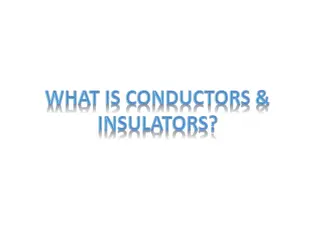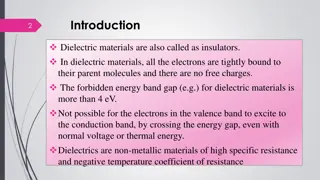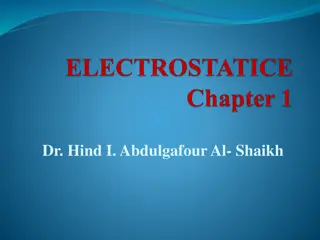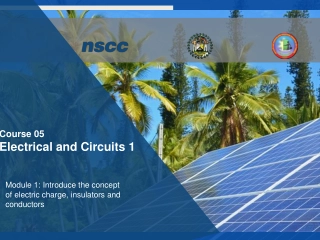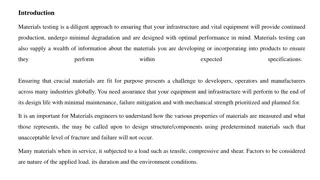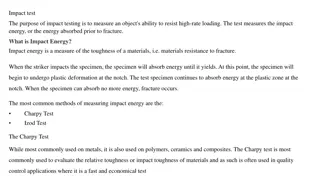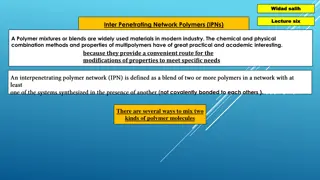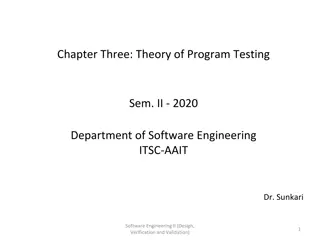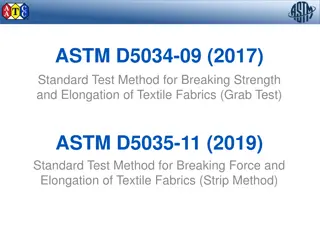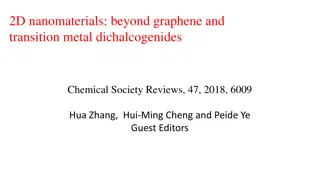Understanding Insulators: Properties, Materials, and Testing
An insulator is a crucial device used to support and insulate electric conductors or equipment from ground or other conductors. This article covers the definition, desirable properties, materials used, ratings, and testing methods of insulators, including flashover tests, sample tests, and routine tests. Explore the importance of high mechanical strength, electrical resistance, and other key factors in insulator design.
Download Presentation

Please find below an Image/Link to download the presentation.
The content on the website is provided AS IS for your information and personal use only. It may not be sold, licensed, or shared on other websites without obtaining consent from the author. Download presentation by click this link. If you encounter any issues during the download, it is possible that the publisher has removed the file from their server.
E N D
Presentation Transcript
Definition An insulator is a device intended to give flexible or rigid support to electric conductors or equipment and to insulate these conductors or equipment from ground or from otherconductorsorequipment. Overhead transmission lines are supported on the towers. Since towers are at ground potential, the lines must be insulated from the towerstructure.
Desirable Properties High mechanical strength in order to withstand conductor load, wind load, etc. High electrical resistance of insulator material in order toavoid leakage currents toearth. High relative permittivity of insulator material in order thatdielectricstrength is high. The insulator material should be non-pores, free from impurities and cracks other wise the permittivity will be lowered. High ratio of puncturestrength to flashover.
Materials Porcelain Toughened Glass Polymericcomposite Choice of availability, price and easeof maintenance. Porcelain is most widely used insulator material as it is cheap. insulator material is governed by
Ratings of Insulators Insulators are rated by three voltages: Working Voltage (Rated Voltage): is the voltage at which an insulator is designed to bear the steady state voltage stress. If the line voltage is VLL,the working voltage is VLL/ 3 2. Flashover Voltage: is the voltage at which flashover occurs through airsurrounding insulator. 3. Puncture Voltage: is the voltage at which the insulator break through between conductorand pin. 1.
Flashover voltage is higher than working voltage and less than the puncturevoltageof the insulator. A safety factor is defined as a ratio of flashover voltage toworking voltage. Safety factor = FlashoverVoltage/Working Voltage
Testing of Insulators Flashover Tests: 50 % dry impulse flashover test Dry flashover and dry one-minute test Wet flashover and one-minute rain test II. Sample Tests: Temperature cycle test Mechanical test I. a) b) c) d) e)
Electro-mechanical test Puncture test Porosity test III. Routine Tests: Electrical routine test Mechanical routine test f) g) h) i) j)
Types of Insulators There are several types of insulators but the most commonly used are: pin type suspension type strain insulator and shackle insulator
Pin Type Insulators As the name suggests, the pin type insulator is secured to the crossarm on the pole. There is a groove on the upper end of the insulator for housing the conductor. The conductor passes through this groove and is annealed wire of the same material as the conductor. bound by the
Pin type insulators are used transmission and electric poweratvoltages up to 33 kV. Beyond operating voltage of 33 kV, the pin type insulators become too bulky and hence uneconomical. A single pin type insulator is used to transmit voltages (kilovolts) and higher voltages require two-, three- or insulators. for of distribution up to 11 kV four piece pin
They feasible higher transmission lines. Pin type insulators are secured with steel or lead bolts onto transmission poles. These are typically used for straight-running lines. are not economically kV for 33 and transmission
Suspension Type Insulators For high voltages (>33 kV), it is a usual practice to use suspension type insulators consist of a number of porcelain discs connected in series by metal links in the form of a string.
The conductor is suspended at the bottom end of this string while the other end of the string is secured to the cross-arm of the tower. Each unit or disc is designed for low voltage, say 11 kV. The number of discs in series would obviouslydepend upon theworking voltage. For instance, if the working voltage is 66 kV, then six discs in series will be provided on the string.
Advantagesof suspension type insulators Suspension type insulators are cheaper than pin type insulators forvoltages beyond 33 KV. 2. Each unit or disc of suspension type insulator is designed for low voltage, usually 11 kV. Depending upon the working voltage, the desired number of discs can be connected in series. 1.
3. If any one disc is damaged, the whole string does not become useless because the damaged disc can be replaced by the sound one. 4. The suspension arrangement flexibility to the line. The connection at the cross arm is such that insulator string is free to swing in any direction and can take up the position where mechanical stressesare minimum. provides greater
5. In case of increased demand on the transmission line, it is found more satisfactory to supply the greater demand by raising the line voltage than to provide another set of conductors. The additional insulation required for the raised voltage can be easily obtained in the suspension arrangement by adding the desired numberof discs. 6. The suspension type insulators are generally used with steel towers. As the conductors run below the earthed cross-arm of the tower, therefore, this arrangement provides lightning. partial protection from
Strain Type Insulators When there is a dead end of the line or there is corner orsharp curve, the line is subjected togreater tension. In order to relieve the line of excessive tension, strain insulatorsare used. For low voltage lines (< 11 kV), shackle insulators are used as strain insulators.
However, for the high voltage transmission lines, strain insulator consists of an assembly of suspension insulators. The discs of strain insulators are used in the vertical plane. When the tension in lines is exceedingly high, at long river spans, two or more strings are used in parallel.
Strain type insulators are horizontally suspended suspension insulators. They are used to handle mechanical stresses and take the pressure off a conductor at the end of a transmission line, at a sharp corner or curve or over long rivercrossings. Strain insulators are typically used for higher voltage transmissions.
Shackle Type Insulators Shackle type insulators, are used on sharp curves, end poles and in section poles. insulators, similar to strain type
These insulators are single, round porcelain parts that are mounted horizontallyorvertically. In early days, the shackle insulators were used as strain insulators. But now a days, they are frequently used for low voltagedistribution lines. They can be directly fixed to the pole with a bolt or to the crossarm.
Voltage Distribution across Suspension Insulators
The following points may be noted regarding the potential distribution over a string of suspension insulators: The voltage impressed on a string of suspension insulators does not distribute itself uniformly across the individual discs due to the presence of shunt capacitance. The disc nearest to the conductor has maximum voltage across it. As we move towards the cross-arm, thevoltageacrosseach discgoes on decreasing. i. ii.
iii. The disc nearest to the conductor is under maximum electrical stress and is likely to be punctured. Therefore, means must be provided to equalize the potential acrosseach unit. iv. If the voltage impressed across the string is dc, then voltage across each unit would be the same. It is because insulatorcapacitances are ineffective fordc.
String Efficiency Where n is the total number of discs in the string. The greater the string efficiency, the more uniform is the voltage distribution.
Mathematical Expression Let: 3-disc string Self (mutual) capacitance = C Shunt capacitance (C1) = KC (fraction of C)
Methods to Improve String Efficiency By using longer cross arms (Reducing the value of K) 1. 2. By grading the insulator (Capacitance grading) 3. By using a guard ring


